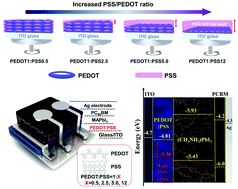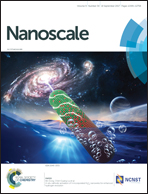Thermodynamically self-organized hole transport layers for high-efficiency inverted-planar perovskite solar cells†
Abstract
Poly(3,4-ethylenedioxythiophene):poly(styrenesulfonate) (PEDOT:PSS) is a popular and promising hole transport material for making efficient inverted-planar perovskite solar cells (IP-PSCs). However, the mismatch between the work function of conventional PEDOT:PSS and the valence band maximum of perovskite materials is still a challenge for efficient hole extraction. Here, we report systematic studies on the work-function modification and thermodynamic morphological evolution of PEDOT:PSS films by tuning the PSS/PEDOT ratio, along with its effects on the photovoltaic responses of IP-PSCs. We found that the open-circuit voltage (VOC) of an IP-PSC could be enhanced by controlling the work function of PEDOT:PSS. Furthermore, the optical transmittance of the PEDOT:PSS film could be maximized by controlling the morphological evolution, which will further increase the short-circuit current density (JSC) of the IP-PSC. The VOC and JSC of the IP-PSC with the optimized PEDOT:PSS composition increased from 0.88 to 0.93 V and from 17.11 to 20.77 mA cm−2, respectively, compared with an IP-PSC containing commercial PEDOT:PSS, which results in a power conversion energy that is greatly improved from 12.39 to 15.24%.



 Please wait while we load your content...
Please wait while we load your content...